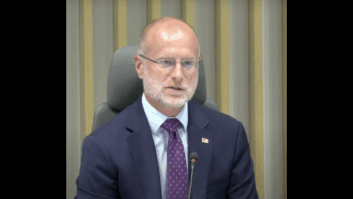
With fires consuming towns on the West Coast and hurricanes damaging communities in the east, the issue of preparing for natural disasters has never seemed more essential.
That issue is clear to the head of the safety and security bureau at the Federal Communications Commission who released a statement as part of September’s National Preparedness Month to recap the latest developments in the nation’s Wireless Emergency Alert plans. Lisa M. Fowlkes, chief of the FCC’s Public Safety and Homeland Security Bureau, also detailed how emergency managers and the public can best go about taking advantage of this tool.
[Read: FEMA Says No National Alert Test This Year]
One of the most significant improvements to the system is enhanced geo-targeting options for Wireless Emergency Alerts. Starting in December 2019, participating wireless providers must provide the ability to deliver alerts on a mobile device to a specific area targeted by emergency management officials — no longer just blanket the entire county — with no more than a one-tenth of a mile overshoot.
The commission also recently requested that the CTIA, the trade association representing the communications industry, provide to the FCC an annual report with estimates of current and projected market penetration rates of mobile devices supporting enhanced WEA geo-targeting starting in July 2021. A similar request was sent to the standards organization Alliance for Telecommunications Industry Solutions as well as to Qualcomm to confirm the chip manufacturer’s support for enhanced geo-targeting.
Fowlkes also highlighted the ability for public health officials to send Wireless Emergency Alerts with enhanced information — up to 360 characters from the original limit of 90 characters — and the capability for officials to send alerts in Spanish. She also touted a new class of alerts called Public Safety Messages to convey information such as the location of emergency shelters after a disaster.
In addition, Fowlkes said, as of December emergency managers can conduct state and local WEA tests that reach only consumers who choose to participate, noting that these tests do not require a waiver from the FCC.
In addition to releasing a set of tips for using the new Wireless Emergency Alert enhancements and for issuing multilingual alerts, Fowlkes also urged consumers themselves to take an important step: keep Wireless Emergency Alerts enabled on their phones.
“While it’s possible to turn most of these alerts off, they are proven life savers — so please keep them on,” she said.







